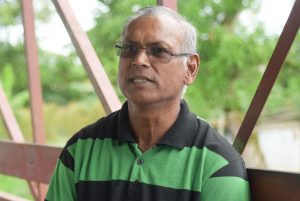The sugar that built me: Belle Vue elders reflect 62 years on
By Shemuel Fanfair
Located in the environs of the former Wales Sugar Estate is the breezy community of Belle Vue, West Bank Demerara (WBD), a village which was built on sugar and thrived during the heyday of sugar production.
In fact, the village celebrated its 62nd year in existence this past year and was said to be the first and only pilot scheme established by the Bookers Sugar Estate, which ran the industry from the colonial era up to 1970.
The ‘Belle Vue Pilot Scheme’ as it was then known saw 57 male sugar workers and their families from various estates across East and West Demerara being transplanted to the WBD village under a project that made them sugar cane farmers. It was felt that once workers cultivated their own produce that they would sell the cane to the estate and industrial conflict would be minimised as farmers would not strike against themselves.
However, two of the estate workers turned farmers dropped out of the scheme shortly after and 55 remained. Today, all of those 55 couples have passed away – save for one of the wives, 86-year-old Jamonee Mangra, who resides on Third Street, Bellevue.
It was a regular and calm early afternoon when I met up with the soft-spoken but sharp mother of nine. It was after her lunch period and she sat by her downstairs window taking in the relaxing winds emanating from the Demerara River, which runs adjacent to the community.
She reminisced about married life to her husband, whose only name was Mangra. He died in April 1990 and Mrs Mangra recalled with ease that she and her husband were among the first set of occupants that moved into the scheme in August 1956.
“When I came on this street, it only had seven houses complete and the other ones bin a build on the opposite side. The others come March 1957. People come from far and near and all ah we come and live; some come from Grove, Diamond, all about … Manager tell we leh we come here and he ah gie we house for live. People always used to talk to each other,” she fondly recalled.
The elderly woman, who had a somewhat restrained smile, said that when she first came from Wales, she helped her husband plant cane. Those were arduous days which began around 03:00h when she prepared meals for her household. Jamonee was born near the Mahaica market area and went to Vriesland, WBD, at six years of age as a result of her father’s death.
Mrs Mangra bore 11 children from which five sons and four daughters remain alive. The elder explained that she has about 30 grandchildren, and multiple great-grandchildren and great-great grandchildren though providing the exact number was difficult. She, however, remembered clearly that all holidays in Belle Vue whether it was Christian, Hindu or Muslim would all be celebrated in togetherness.
“Ah we live together, we come together, ah we mattie … the world ah we own. All ah we come in this world as a family ‘cause God make ah we and who got passion got passion but me nah got passion,” the elderly woman stated with great fervency.

Today, she lives with her youngest child, who is in her 40s while her eldest child who lives overseas is in her 70s. Mrs Mangra said finally that she would most want to see cane being milled at the Wales Estate again as many of her children built their lives around the industry.
One of her neighbours, Ramnarine Ragaloo, 79, called “Uncle Aaron” was born in Grove, East Bank Demerara (EBD) and had many similar sentiments to Mangra regarding the unity that permeated Belle Vue. He said that at any time, neighbours or even strangers could visit various homes and be offered a meal. He indicated that as a teenaged lad, he was the last of his relatives to go over to Belle Vue shortly after the scheme was established.
Uncle Aaron said that while he lived at Grove, he worked at Diamond Estate throwing manure and started to plant cane at Belle Vue after he joined his parents, ‘Jasodra’ and ‘Ragaloo’. One of the amenities in these original 15 by 20 foot homes were indoor toilets and a sewerage system.
“When we come we had seven houses pun one line on the toilet system and every 20 minutes to half hour, the toilets flushed automatically,” Uncle Aaron explained, noting that there was an overhead tank that stored water, which also flowed to two stand pipes in every street.
When the scheme started there were no trees and the concrete two-storey houses included upstairs bedrooms that were 8 by 10 feet with a kitchen on the ground floor. Uncle Aaron saw the scheme as a developed place; however, he along with other residents said that many persons in the surrounding villages would aim remarks at them when they passed the villages on their bicycles, saying that Belle Vue’s inhabitants were living in prison.

